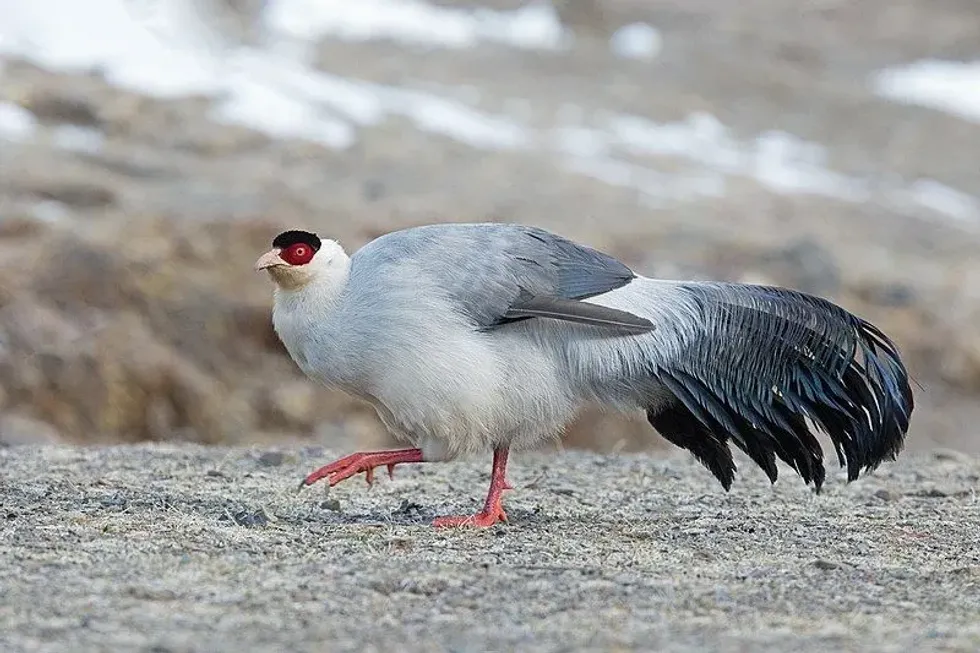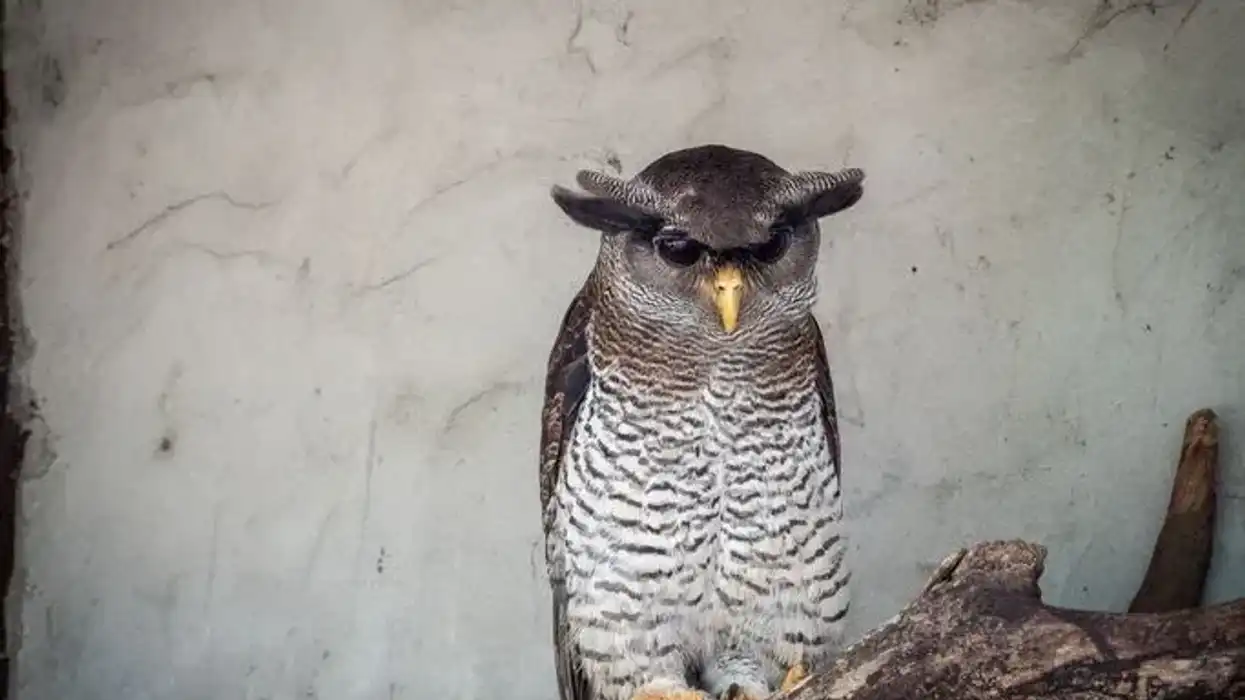With white plumage, a black crown, dark tail, and red facial skin near the eyes, the white eared pheasant (Crossoptilon crossoptilon) is an exotic wild bird native to western China, India, and Tibet. Even though it is named such, it doesn't have white ears; instead, it has tiny white ears tufts.
It dwells in alpine meadows located at 9186.4-15091.9 ft (2800-4600 m). There are four subspecies of these birds. The local Himalayan people call these birds shagga, which in their local dialect means snow fowl.
These eared pheasants are social birds and lives in large flocks. The species was named by Brian Houghton Hodgson, a British Naturalist, and Ethnologist back in 1838.
The term Crossoptilon comes from two Greek words, krossoi and ptilon, which means feather and fringe respectively. In this write-up, we will introduce you to facts about this elegant wild bird from Asia. If you are keen to learn more about birds, give our article on senegal parrot facts and fox sparrow facts a read.
White Eared Pheasant Interesting Facts
What type of animal is a white eared pheasant?
White eared pheasants are birds of the species eared pheasant.
What class of animal does a white eared pheasant belong to?
A white eared pheasant (Crossoptilon crossoptilon) belongs to class Aves, order Galliformes, family Phasianidae, and Genus Crossoptilon.
How many white eared pheasants are there in the world?
An estimated 10,000-50,000 birds exist in the wild today, of which about 6,700-33,000 are thought to be mature.
Where does a white eared pheasant live?
These pheasants live in alpine meadows in Western China, Tibet, and the Himalayan region of India. They are found in southern Qinghai, southeastern Tibet, western Szechuan, and northwestern Yunnan in China.
What is a white eared pheasant's habitat?
The typical habitat of these birds is mountain forest areas. It lives in coniferous and mixed forest and rhododendron shrub and subalpine birch.
They are hardy birds and adapt well to a cold climate, and can be found at high altitudes of about 13779.5 ft (4200 m) throughout the year. Factors like water, predators, and the availability of foraging sites play a role in its population distribution.
They are mostly found around pine and oak forests in the Tibetan range. They can be commonly sighted around the Buddhist monasteries, where they are considered sacred and culturally protected.
In the Himalayas, they live in montane forests, coniferous forests and are also seen in mixed forests during summer. In Western China, they are found near the Yangtze River, where over rocky slopes, rhododendron shrubs, juniper, dogrose, and barberries are abundant.
Who does white eared pheasant live with?
It is considered monogamous during the breeding season and is seen living in pairs during the mating season. It is a social bird and loves company. In its natural habitat, you will see them living and going around in search of food in large flocks.
How long does a white eared pheasant live?
The average lifespan of these birds in the wild is three years. However, it can live as long as 15-25 years in captivity with good care.
How do they reproduce?
These birds reach sexual maturity later in their second year. The breeding season starts from April to June end.
Since not much sexual dimorphism is seen in this species, they are thought to be monogamous when breeding. To entice the female partner, the male displays specific behavior; he raises his tail, inflates his facial skin, lowers his wings, runs around the female, and indulges in the characteristic pheasant scream.
The nests of white eared pheasants are generally placed on the ground with some cover from trees. The range of the average clutch size is 6-9, and eggs are laid with a break of few days in between.
The incubation happens over a range of 25-29 days, after which the chick hatches. The chicks grow faster, and by ten days, they are twice the weight at birth.
Females are slightly smaller than males. Interestingly, all species of eared pheasants can mate interchangeably, and when the hybrids are sexually mature, they can have offspring.
What is their conservation status?
Habitat loss due to deforestation and hunting are two leading causes of its vulnerable declining population. The range of their natural habitat is limited, and the population is showing decreasing trend over the past years. It is listed in the Near Threatened category in the IUCN Redlist.
White Eared Pheasant Fun Facts
What do white eared pheasants look like?
The description of white eared pheasant (Crossoptilon crossoptilon) is simple; it has a small head as compared to its body. The head is adorned with a soft black cap.
It has white plumage, the area around the eye is featherless and is bright red in color. It has small eyes, short, strong legs, and a powerful pink beak which it uses to peck at things when in search of food.
Its tail consists of 20 feathers that are black with a bluish tinge.
This species of pheasants is less fluffy, and its plumage is not feathered. Although they are named 'eared,' the ears are not very visible as you can see in the photos; instead, tiny ear tufts can be seen.
How cute are they?
These birds have a striking appearance with their snow-white plumage, the prominent red area around the eye, and the black cap at their head. It looks simple, elegant, and attractive.
How do they communicate?
The male and female can be heard throughout the year in a far-reaching call and sounds like raucous grating.
How big is a white eared pheasant?
It is a reasonably large bird and can grow up about 3.3 ft (1 m) in length. Among eared pheasants, this species is the largest. Males are slightly heavier than the female. It measures about 29.5-39.4 in (75-100 cm) in length.
How fast can a white eared pheasant run?
White eared pheasants prefer running over flying. Although it can fly well and has the ability for sustained flight, it tends to flee when it senses danger from predators and can cover hundreds of meters in a few seconds at a speed of 8-10 mph (12.9-16.09 kph).
How much does a white eared pheasant weigh?
The average weight for males is about 5.18-6.06 lb (2350–2750 g) and 3.09-4.5 lb (1400–2050 g) for females.
What are the male and female names of the species?
The male of the species is also called a rooster, and the female is called a hen.
What would you call a baby white eared pheasant?
A baby white eared pheasant is often referred to as a chick.
What do they eat?
In their natural habitat, they are typically omnivores. Their diet primarily consists of plant foods like tubers, seeds, grains, berries, bulbs, roots, and leaves. They also eat worms, insects, slugs, for their protein intake.
They feast on juniper berries during autumn as it is plenty in their natural habitat. When other food sources are scarce in winter, they survive on pine needles, dried flower seeds, wolfberries. When there is a snowstorm, it picks on the litter balls of alpine animals for nutrition in adverse conditions.
Are they poisonous?
There is no information about this species being poisonous.
Would they make a good pet?
Outside their natural habitat, they are reared in some countries where the climate is conducive. Unlike other pheasants, the eared pheasants are considered one of the calmest pheasant species in captivity.
However, they need space, and it is vital to keep them in a large aviary with lots of plants. In aviculture, the Drouyni and Szechuan subspecies are most common. In captivity, it is essential to keep them in pairs.
Did you know...
There are four recognized subspecies of white eared pheasants, namely Szechuan white-eared pheasant (C. c. crossopitlon), Dolan's Pheasant ( C. c. dolani), Drouyni Pheasant (C. c. drouyni), and Yunnan Pheasants ( C. c. lichiangense). In addition, there is another called Harman's eared pheasant C. harmani, which is often listed as a subspecies.
The one found in Szechuan has a snow-white chin while the rest of the body is creamish white. Its wings have a grayish tinge, while the primaries are brown to dark grey.
Their population is decreasing due to hunting and is listed as vulnerable. The Dolan's pheasants typically have a white belly and pale grey wings.
The Drouyni pheasant is Tibetan with a white body and wings and little light grey on the mantle. The description of Yunnan pheasants is the same as crossopitlon with a bit of grey on wings.
Harman's eared pheasant is sometimes also called the Tibetan pheasant, is dark grey.
How high can they fly?
Even though they are capable of flying long distances, they tend to use their legs more. They can hover or volplane their way through thick snow by fluttering their wing close to the ground.
For balancing and maintaining their weight, they use their tail feathers. However, compared to the other eared pheasant species like the wild brown eared pheasant, the white eared pheasant (Crossoptilon crossoptilon) tend to fly more. Their flight is often comparable to that of royal pheasant or partridge.
Are they predators?
No, they are not predators.
Here at Kidadl, we have carefully created lots of interesting family-friendly animal facts for everyone to discover! For more relatable content, check out these crowned eagle facts and Cooper's hawk facts pages.
You can even occupy yourself at home by coloring in one of our free printable white eared pheasant coloring pages.









